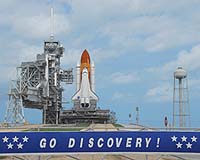 |
Cape Canaveral, Florida (AFP) Aug 24, 2009 NASA on Monday began filling the external fuel tank of the shuttle Discovery, one day before it blasts off toward the International Space Station carrying a crew of seven astronauts. As space officials prepared for Tuesday's launch, they said they saw nothing worrisome at this time that would lead to a delay. "Everything looks normal. There is no technical issue to report," said NASA spokesman George Diller. Mission officials said there is an 80 percent chance of launch-friendly meteorological conditions, although there is a slight risk of thunderstorms and lightning within an eight-kilometer (five-mile) area of the launchpad. Discovery's liftoff is set for 0136 am (0536 GMT) Tuesday from Kennedy Space Center in Cape Canaveral, Florida. The task of filling the enormous reservoir, which got underway about 10 minutes late, was to be completed at 7:15 pm (23H15 GMT), US space officials said. The space vehicle's external fuel tank was being filled with nearly two million liters of liquid hydrogen and oxygen. Discovery is to deliver equipment for a new bedroom, a treadmill, a freezer, food and other supplies. It will also be dropping off the newest member of the ISS team -- US astronaut Nicole Stott. Stott will be taking over from engineer and fellow American Tim Kopra, who has been aboard the ISS since July and is returning to Earth with the Discovery. The Discovery crew, led by astronaut Rick Sturckow, will be delivering 6.8 tonnes of cargo transported in a pressurized module called Leonardo that was built by the Italian space agency. Two astronauts from the team are scheduled to conduct three spacewalks of six and a half hours each during the 13-day mission, which is the fourth of five planned for the shuttle this year. The last is scheduled for November. One of the key goals of the space walks is the replacement of an old liquid ammonia tank, which will be substituted with a new 800 kilogram replacement brought from Earth aboard the Discovery. The substance is used as a coolant. The astronauts will also be retrieving experiment equipment from the outside of the ISS and returning it to Earth for processing. The new freezer will store samples of blood, urine and other materials that will eventually be taken back to Earth for study on the effects of zero-gravity. The COLBERT treadmill, named after popular US comedy talkshow host Stephen Colbert, will be the second aboard the ISS. Exercise is key for astronauts spending long periods of time in space, where zero-gravity can result in muscle atrophy. Among the seven-member crew is veteran European astronaut Christer Fugglesang, 52, of Sweden. The shuttle flight also is the first with two Hispanic astronauts: veteran mission specialist John "Danny" Olivas, 44, of El Paso, Texas, and rookie Jose Hernandez, 47, of Stockton, California. Hernandez will provide bilingual Twitter updates from space, via Twitter.com. The mission will be the 128th for the space shuttle program, and the 30th mission to the ISS. Once the Discovery mission is complete, just six more shuttle flights remain before NASA's three shuttles are retired in September 2010. The International Space Station is a project jointly run by 16 countries at a cost of 100 billion dollars -- largely financed by the United States. Share This Article With Planet Earth
Related Links Shuttle at NASA Watch NASA TV via Space.TV Space Shuttle News at Space-Travel.Com
 Discovery gets the all-clear for Tuesday launch of international crew
Discovery gets the all-clear for Tuesday launch of international crewWashington (AFP) Aug 23, 2009 NASA gave a final green light to continue the countdown to the launch of the shuttle Discovery Tuesday toward the International Space Station, carrying a crew of seven including a Swede. Mission officials said at a press briefing Sunday they saw no likely technical hurdles to takeoff August 25 at 0136 am (0536 GMT) from Kennedy Space Center in Cape Canaveral, Florida. ... read more |
|
| The content herein, unless otherwise known to be public domain, are Copyright 1995-2009 - SpaceDaily. AFP and UPI Wire Stories are copyright Agence France-Presse and United Press International. ESA Portal Reports are copyright European Space Agency. All NASA sourced material is public domain. Additional copyrights may apply in whole or part to other bona fide parties. Advertising does not imply endorsement,agreement or approval of any opinions, statements or information provided by SpaceDaily on any Web page published or hosted by SpaceDaily. Privacy Statement |